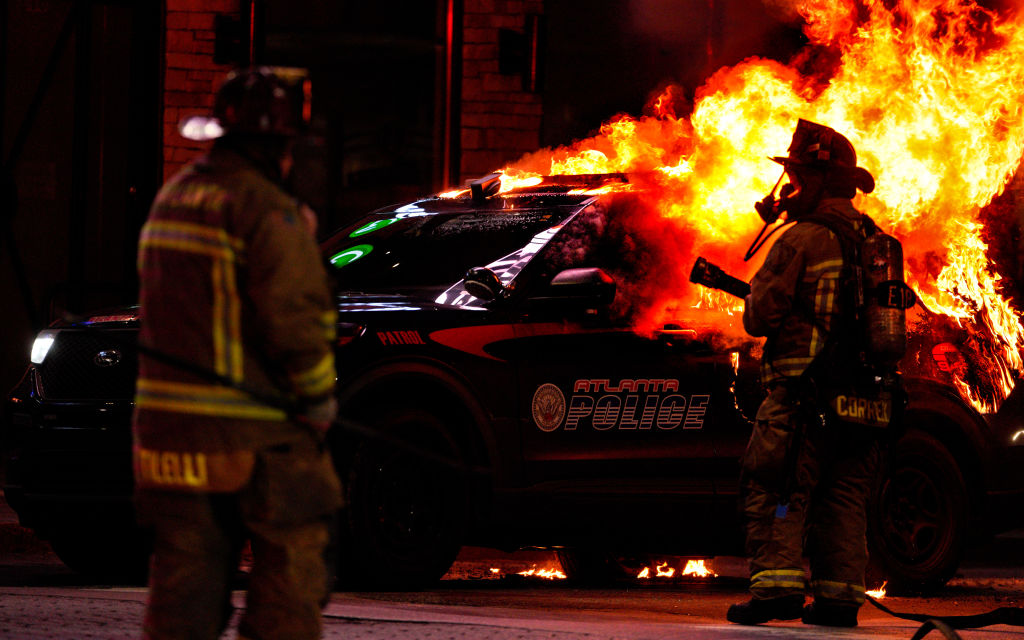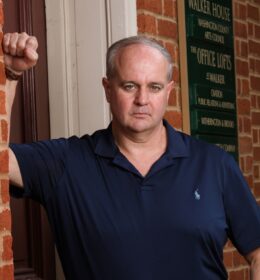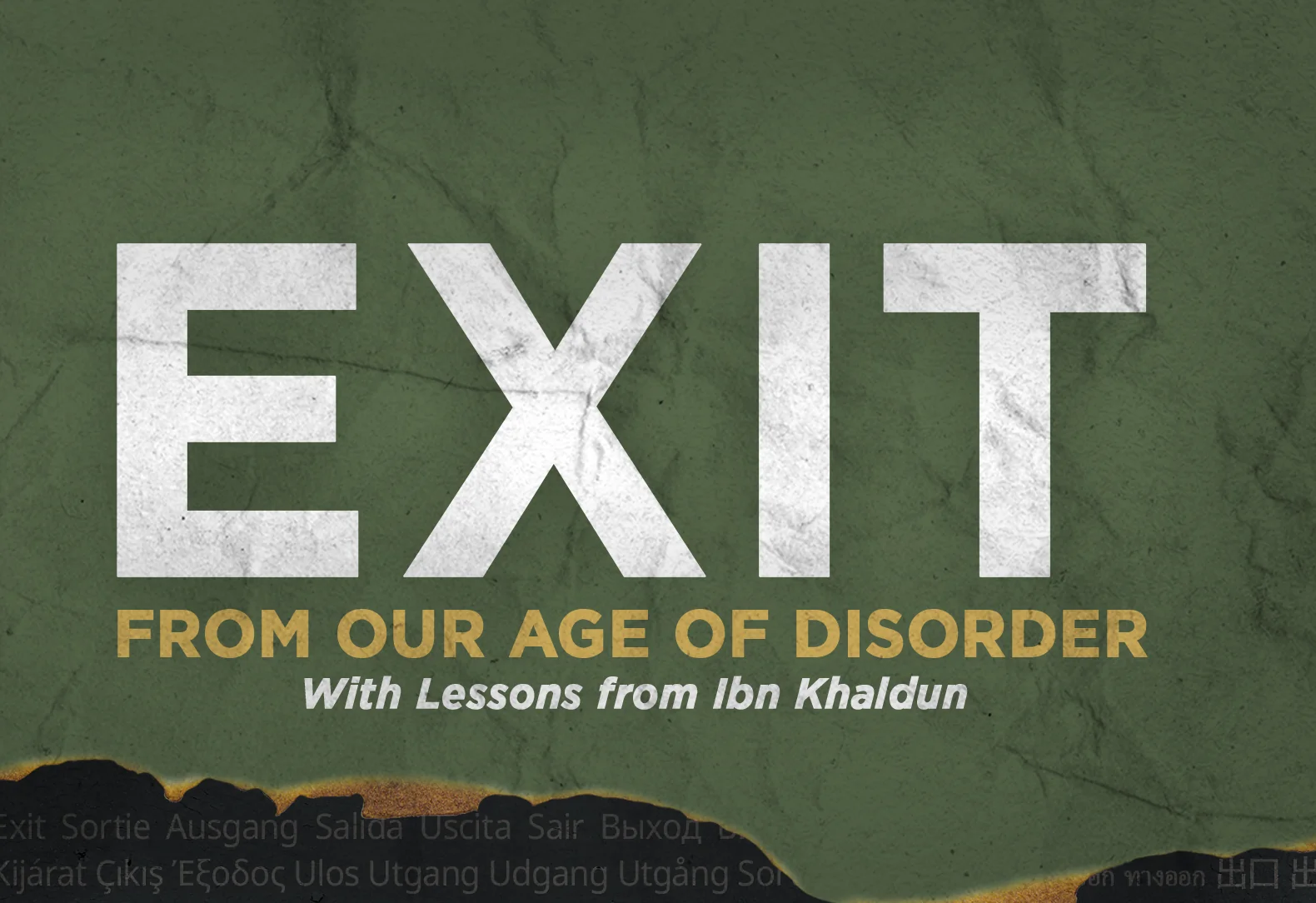Though far-right actors are the primary threat to the U.S. homeland (50 states and territories), far-left extremist violence, including lethal attack capabilities, cannot be overlooked or overestimated. There is increased risk of social turmoil and political violence by violent far-left extremists for at least the next 12 months as the United States enters its national election season. Political tensions arising from many of the issues driving far-left mobilization are intensifying and exacerbated by the likely presidential candidacy of incendiary former President Donald Trump.
While extremely active during the Cold War, violent far-leftists experienced a post-Cold War lull until the mid-2010s. Since then, they have been energized by a variety of issues such as minority rights, growing negative impacts of climate change, economic inequality, threats to democratic norms and institutions, a desire to counter-mobilize against a resurgent far-right movement, and most recently, violence in Israel and the Palestinian Territories.
Far-leftists generally avoid fatal violence, favoring disruptive and oft-destructive but non-fatal “direct action.” However, some evidence suggests that internal constraints against homicidal action are eroding. This erosion has to do largely with environmental factors but is also enabled by far-leftists’ ideologically and operationally motivated eschewal of formal organizational structures.
Policymakers can take steps to address the potential for violent – and possibly fatal – actions from violent far-leftists:
- Depoliticize issues by setting a responsible tone
- Defuse tensions at a local level
- Employ targeted enforcement based on individualized suspicion of criminal wrongdoing
- To the extent it exists, mitigate politically motivated bias within law enforcement
Who Are Violent Far-Left Extremists?
When speaking of the “far left,” this is in reference to actors who hold beliefs that advocate for social egalitarianism but are otherwise hostile to the procedural and behavioral norms of liberal democracy (i.e. display illiberal and/or authoritarian behaviors). There are at least four distinct subcurrents within this umbrella category:
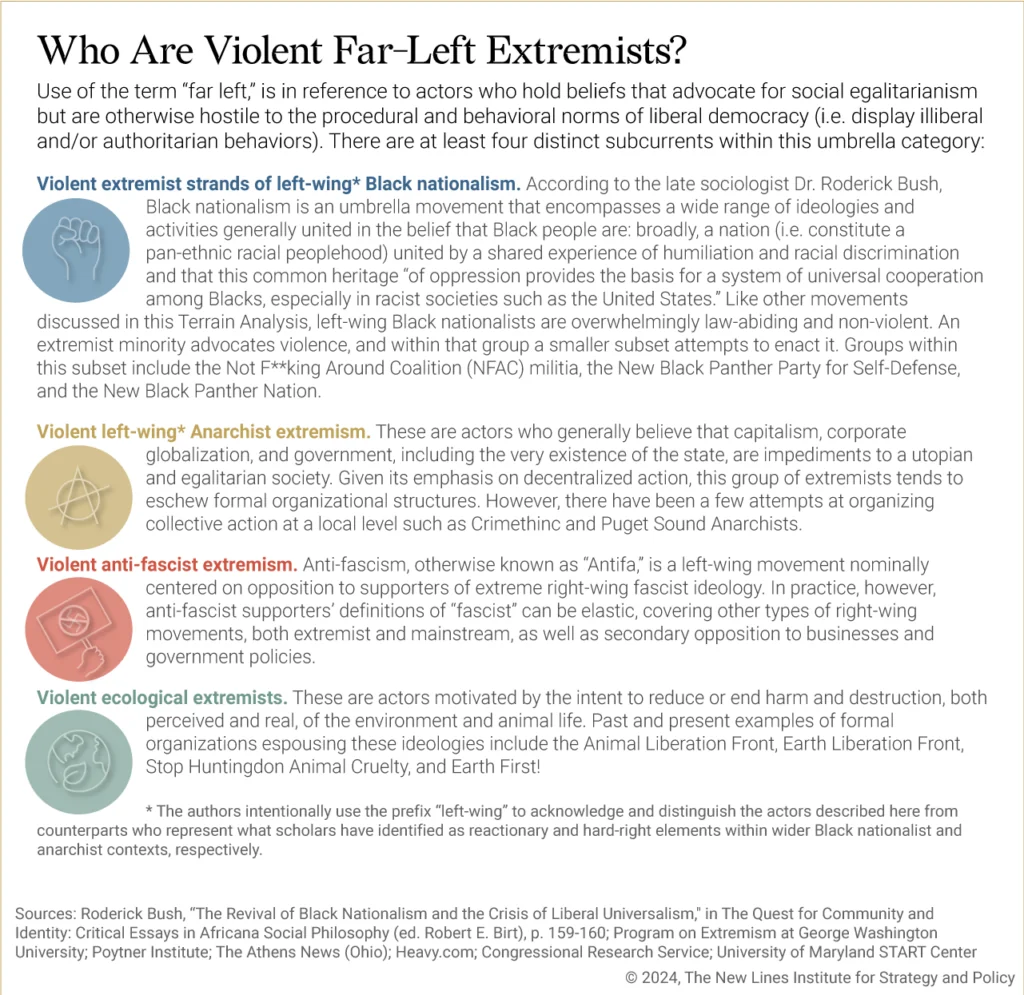
Although representing distinct subcurrents within a wider far-left milieu, these violent far-left extremist groups are often intertwined with each other. Sometimes, actors’ central mobilizing principles constitute a fusion of different sub-ideological beliefs. An example is Root Force, a short-lived violent collective based on an ideology combining the beliefs of ecological extremism and left-wing anarchism, known as “Green Anarchism.” In other cases, discussed further in this Terrain Analysis, actors work together in a coalition centered on a specific issue of shared interest rather than a fusion of ideologies.

Background
Violent far-left extremism is not new to contemporary U.S. history. While analysts have noted a resurgent far-left mobilization since the mid-2010s, far-left extremist violence was the dominant ideological manifestation in the 1970s and a major part of the U.S. domestic threat landscape until the early to mid-2000s.
As a result, it has historically garnered significant law enforcement attention. From the 1970s to 1990s, violent far-leftists carried out hundreds of attacks against a wide array of targets. The Weather Underground movement attacked the U.S. Capitol in 1971. The Fuerzas Armadas de Liberación Nacional bombed the Fraunces Tavern in New York City in 1975, and the Black Liberation Army carried out numerous attacks, mostly in New York City and largely targeting police, starting in 1970, stretching well into the early 1980s. With the dissolution of the Soviet Union, as well as successful investigations and prosecutions of violent far-leftists, attacks motivated by social justice, anti-war, and ethno-nationalist goals were declining, only to be filled by incidents caused by violent eco-extremists
Target selection was largely informed by sub-ideology and group/movement goals. For example, Marxist-Leninist groups located in the U.S. mainland mostly focused on attacking police, government facilities, and institutions associated with capitalism, whereas left-wing Puerto Rican independence groups, while also influenced by Marxism, mostly attacked targets in Puerto Rico. The overwhelming majority of these incidents were non-fatal. However, an important historical exception to this trend was the consistent fatal targeting of police officers, which continues to this day.
Another reason for intensive investigation of far-leftists, both criminally offending and law-abiding, was a political climate often characterized by alarmism over the threat, real or perceived, that Marxist-inspired actors posed to the U.S. and its interests. Combined with a lack of legal protections, this enabled widespread domestic spying abuses by federal agencies like the Federal Bureau of Investigation and Central Intelligence Agency that were brought to public attention after the Watergate scandal.
Drivers and Enablers of Mobilization
Several factors contribute to far-left armed mobilization. First are underlying grievances that inspire individuals into action. These include, among other things, wider concerns over the growing gap between rich and poor, effects of climate change, exploitation and cruelty toward animals and the environment, and moral outrage amid the struggle for racial equity and gender rights. Insofar as violent far-leftists are concerned, they share an interest in many, if not all, of these issues, though the extent to which they are emphasized is informed by ideology. For example, eco-extremists will be primarily focused on specific issues and events related to climate change and environmental damage, whereas left-wing Black nationalists are largely mobilized by events related to police brutality and overreach.
However, violent far-leftists often cooperate where they perceive intersectional struggles (where issue interests overlap). The intense high-profile opposition to the planned “Cop City” facility in Atlanta is illustrative in this regard. Local reporting suggests the opposition group called the Forest Defenders is an ad hoc coalition of actors expressing Marxist, left-wing anarchist, and anti-fascist beliefs, driven by a combination of ecological, anti-police, and racial justice views. While most of their activities are non-violent, some supporters have used violence to advance their cause.
Second, they are driven in reaction to specific events as well as larger ongoing dynamics, both domestic and international. Domestically, violent far-leftist mobilization is a reaction to mobilization on the far-right, producing a mutually-reinforcing dynamic analysts have referred to in other geographic contexts as “symbiotic radicalization.” An illustrative example of this dynamic is the politically motivated street violence between far-left and far-right actors that has occurred in Portland, Oregon, for years. Against this backdrop, specific events have provided a catalyst for far-left extremist violence, including high-profile cases of police officers killing people of color, development of pipeline projects on indigenous and environmentally fragile lands, and the Dobbs v. Jackson Women’s Health Organization decision by the U.S. Supreme Court.
International events, namely, the Palestinian-Israeli conflict, have also energized and mobilized far-left actors long before and since the Oct. 7 attacks by Hamas and other armed factions. Although most of this activity is law-abiding and peaceful, there has been steadily growing discourse among far-leftists that condones, glorifies, and implicitly or explicitly threatens violence against those deemed complicit in the oppression of Palestinians. This discourse, much of it explicitly antisemitic, is growing at a time when anti-Muslim prejudice is also surging after Oct. 7. Such rhetoric exacerbates a wider climate of dehumanization, driven by multiple ideological actors, that enables a growing trend of harassment, threats, and violence directed at faith-based entities, elected officials, civic figures, and everyday community members.
Violent far-left mobilization has been enabled by two additional factors. First is the wider tone of elected leaders and opinion shapers. On one hand, many figures on the political right have tended to engage in alarmism that grossly mischaracterizes and overestimates the prevalence of violent far-left activity, thereby inflating the threat. On the other, there have been some figures, mainly on the political left, who downplayed the violence of far-leftists or altogether denied their existence.
Second is certain law enforcement agencies’ responses to threats and attempted acts of political violence. Critics have charged that federal, state, and local agencies have engaged in disparate treatment between far-left and far-right violent actors, with the latter perceived as receiving more favorable treatment than the former. While law enforcement officials deny favoritism and often responded quickly to allegations, their critics point to empirical evidence from, among other things, harsh federal interventions in local political protests, biases in analytic products from federal and state–run analytic entities, and local policing agencies’ seemingly favorable treatment of far-right actors, to substantiate their claims. These claims have drawn parallels to law enforcement/intelligence abuses uncovered in the 1970s and raised questions about entrapment of arrested individuals, misallocation of government resources, and charges of systematic political bias.
Despite enacting internal bureaucratic procedures and guidelines to prevent abuses in domestic federal law enforcement investigations, such as the FBI’s Domestic Investigation Operations Guidelines (DIOG), media reporting suggests intelligence dragnets and other questionable practices have continued in the post-9/11 era. Reports from governmental and think-tank sources point out that safeguards like the DIOG have been progressively relaxed, poorly taught and misunderstood by investigators, and misapplied in the field. This has led to difficulties in managing large amounts of casework generated from expansive authorities as well as disastrous intelligence failures stemming largely from failure to identify credible threats, such as the Jan. 6, 2021, attack on Capitol Hill.
Describing and Assessing the Violent Threat
In the 1970s and 1980s, far-left violent extremists were the primary terrorist threat confronting the United States. Currently, among domestic-focused actors, they are secondary in scale and scope to violent far-right extremists. For example, far-right extremists are known to stockpile large caches of firearms, ammunition, explosives, and other weapons and regularly engage in attacks with the intent of inflicting mass casualties, such as mass shootings. These behaviors have not been commensurately observed among violent far-left actors. Nevertheless, firearms have been present in high-profile attacks against police officers by violent left-wing Black Nationalists, as well as by lone actors targeting federal officials.
That said, far-leftists tend to favor a variety of physical “direct action” behaviors that, according to one online guide to direct action written by anonymous movement insiders, “can take many different forms, from occupying buildings or blocking roads, to more disruptive actions such as property damage or violence.” The more unlawful and physically destructive behaviors include acts of harassment, vandalism, sabotage, arson, and assault using melee weapons or no weapons. In more extreme cases, detailed below, this can include stabbings, shootings, vehicular assault, kidnappings, and explosions.
The general historical and contemporary trend of violent far-leftist targeting has been directed at property. To the extent that far-left violence is directed at people, it is mostly and intentionally non-fatal. This is due to operational and ideological preferences that favor inflicting economic damage (e.g., ending capitalism) and bringing attention to specific issues rather than harming civilians (though an exception to this trend is fatal attacks targeting police officers). Yet, as these authors have noted in previous assessments, there are also signs of possible growing intent to kill non-police civilians, suggesting internal constraints against generating fatalities are eroding.
Below is a brief survey of high-impact far-left violence since 2016, intended to be illustrative, rather than exhaustive:
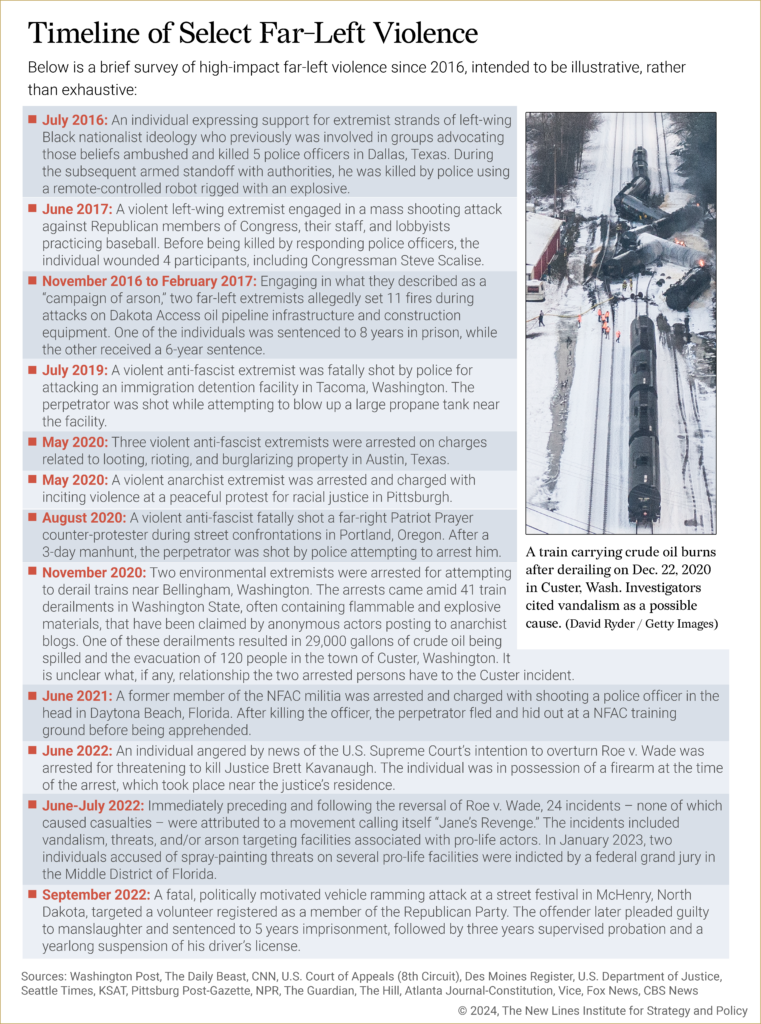
Forecast
Given recent trends and past data showing that violence often increases during the months leading up to and immediately following a national election, there is an increased risk of social turmoil and political violence by violent far-left extremists during 2024 and beyond. They will continue to recruit, radicalize, and mobilize around issues such as perceived social injustice and police brutality, the growing gap between rich and poor, the effects of climate change, and moral outrage amid the struggle for racial equity and gender rights. This is fueled by simplistic, polarizing, and demonizing discourses in the U.S. media landscape, including to a limited extent social media, that contribute to a more morally permissive environment for violence to occur.
As previously discussed, there has been a noticeable shift over the past few years by some violent far-left actors to engage in fatal attacks. While ideology and group/movement norms have played important roles in maintaining “internal brakes” on violent escalation, these endogenous constraints can sometimes fail. There are several reasons for this.
In some cases, there are individuals who simply act on their own with little to no involvement in a group or wider movement and, based on some precipitating triggering event, escalate into violence. For actors within a discrete group or movement, some failures have to do with the wider environment. At an operational level, some actors may feel the need to take measures that escalate the risk of fatal violence (e.g. carry firearms) as a response to threats from adversaries. For example, in response to armed protests outside LGBTQ+ events and establishments, armed far-leftists have been showing up to act as security. At a strategic level, there may be individuals or factions who no longer see the utility in nonviolence or avoiding fatalities, instead viewing murder as necessary toward achieving desired goals.
Finally, much of this is enabled by organizational structure, or in the case of many far-left actors, the lack thereof. As many far-left actors espouse notions of radical egalitarianism, they bring those politics to how they organize and engage in activism. This means that, in addition to operational security considerations, there is often a deliberate eschewal of formal command-and-control structures that could constrain the impulses and behaviors of fringe individuals.
With this context in mind, the current political landscape suggests this emerging trend will continue, and likely grow, in the coming months and years. There is nothing to suggest that violent far-leftists will change their general organizational approach; decentralized and leaderless structures are used to avoid law enforcement scrutiny. Violent far-right extremists who fuel counter-mobilization from violent far-left extremists will be especially energized in 2024.
In addition to being a presidential election year, the frontrunner and likely GOP presidential nominee will be Trump, who, intentionally or not, has had an enormous influence on the entrance of far-right ideas into the right-wing mainstream. Thus, political candidates can be expected to use increased vitriolic rhetoric against their opponents and concerning polarizing social/political issues such as immigration, LGBTQ+ rights, global warming, and perceived authoritarianism, among other topics. All these issues, which are central to the grievances and ideological beliefs of far-left actors, will further motivate them to mobilize, including engaging in violence.
Persistent socio-political polarization, coupled with growing multi-faceted domestic and international issues and conflicts, will continue to fuel rallies and civil disturbances by both the far left and far right. Such gatherings could lead to another round of violent outbreaks between competing protest groups, or worse. Competing armed political assemblies held near each other are at an especially elevated risk of becoming violent.
Conclusion and Recommendations
A recent U.S. Department of Homeland Security terrorism information bulletin states, “the United States remains in a heightened threat environment” from “lone offenders and small groups motivated by a range of ideological beliefs and personal grievances [who continue] to pose a persistent and lethal threat to the Homeland.” The current heightened domestic threat environment emanates from a wide range of adversarial actors, including violent far-left extremists. To mitigate this threat, policymakers can follow these recommendations:
- Depoliticize issues by setting a responsible tone. Some figures on the political right, including elected officials, are engaged in alarmism; some figures on the political left, including elected officials, are engaged in downplaying or denialism. Elected officials and other opinion shapers should take care with their messaging. Though it may be good base politics, polarizing rhetoric sets a public tone that enables terrible policy.
- Defuse tensions at a local level. Amid continued socio-political polarization, exacerbated significantly by the ongoing conflict between Hamas and Israel, there is need to reduce communal tensions that can be used by extremists of various ideological motives to instigate acts of violence. Local communities and institutions of higher education should offer opportunities for facilitated discussion and mediation. One option is the U.S. Department of Justice’s Community Relations Service, whose work in domestic dialogue and conflict resolution has led to be labeled as “America’s Peacemaker.” Another is civil society-led efforts by organizations like the Western States Center to speak out against dehumanizing and hateful speech through action-oriented toolkits and programming.
- Employ targeted enforcement based on individualized suspicion of criminal wrongdoing. Although at first this may seem obvious, the history and current actions of several law enforcement actors give valid reasons to believe that some agents of law enforcement do not follow this recommendation consistently. There is both anecdotal and systematic evidence to suggest entrapment associated with several arrests of alleged violent far-left extremists. This undermines credibility and faith in law enforcement to protect public safety and national security impartially and professionally. Members of Congress and the executive branch should strengthen their oversight of law enforcement activities, including re-examination and strengthening of existing administrative safeguards (e.g. the DIOG). Legislative changes should focus on domestic terrorism legislation aimed at defining and delineating roles and responsibilities among various federal agencies. Ample authorities exist at federal and state levels to investigate and prosecute criminal behaviors in furtherance of extremist violence. Additional legislation that seeks penalty enhancements for acts of domestic terrorism is unnecessary at best and appears to be open to prosecutorial abuse at worst.
- Have safety protocols in locations where there is a high likelihood of dueling political assemblies that will attract violence. In the past, extremists have used election campaign season to organize rallies, as well as show up as counter-protesters to others. While otherwise engaging their constitutional rights to expression and assembly, increased contact between opposing groups of people using heated language increases the risk of violence, especially when firearms are present. Local and state law enforcement should adopt a range of research-informed practices that upholds both the constitutional rights of free expression and assembly, as well as public safety.
- To the extent it exists, mitigate politically motivated bias within law enforcement. Critics have charged several law enforcement agencies with failing to act impartially and professionally, particularly when comparing how violent far-left and far-right actors have been treated. Law enforcement officials at all levels should maintain an apolitical tone among rank-and-file and when communicating with the wider public. The authors also reiterate their earlier calls to remove and/or mitigate the negative impacts of extremists from law enforcement agencies. Consistent with the previous recommendation, the authors also urge greater oversight to ensure law enforcement information products are developed with the highest quality control standards to avoid spreading disinformation and distorting awareness about existing threats. Finally, policymakers should collect data on the nature and extent of ideologically motivated misconduct and potential insider threats among law enforcement personnel at federal, state, and local levels.
Alejandro J. Beutel is a Non-Resident Fellow at the New Lines Institute, specializing in the study and analysis of violent and non-violent Islamist and far-right movements. He is also a Research Affiliate at the National Consortium for the Study of Terrorism and Responses to Terrorism (START). Beutel graduated from the University of Maryland, College Park in 2013 with a Master of Public Policy. He also has a Bachelor of Science in International Relations and Diplomacy from Seton Hall University in South Orange, NJ.
Daryl Johnson is one of the foremost experts on domestic extremist groups in the US. He is a Non-Resident Fellow at the New Lines Institute. He is currently the founder of DT Analytics, a private consulting firm for law enforcement. He is also regularly cited, featured, or quoted in media covering domestic extremist groups in the US, including the New York Times, Washington Post, Wall Street Journal, Newsweek, National Public Radio, MSNBC, CNN, and NBC Nightly News, among many others. He is the author of “Hateland: A Long, Hard Look at America’s Extremist Heart” (Prometheus Books, 2019) and “Right-Wing Resurgence: How a Domestic Terrorism Threat Is Being Ignored” (Rowman & Littlefield, 2012).
The views expressed in this article are those of the author and not an official policy or position of the New Lines Institute.

